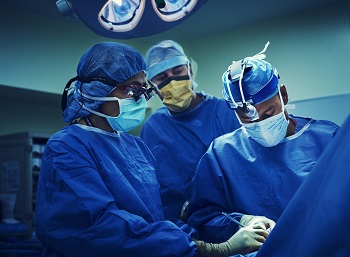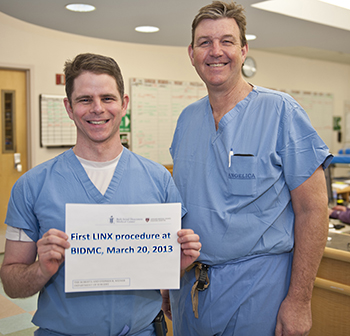Benign Esophageal Disease Program
BIDMC's Benign Esophageal Disease Program treats diseases that affect swallowing, as well as conditions causing heartburn.
 Our specialists in the Division of Thoracic Surgery and Interventional Pulmonology specialize in the treatment of patients with benign esophageal diseases. This includes patients with achalasia, hiatal hernia, and gastroesophageal reflux disease (GERD), among others. In most cases the laparoscopic approach is used, which results in less pain and scaring and a shorter recovery time.
Our specialists in the Division of Thoracic Surgery and Interventional Pulmonology specialize in the treatment of patients with benign esophageal diseases. This includes patients with achalasia, hiatal hernia, and gastroesophageal reflux disease (GERD), among others. In most cases the laparoscopic approach is used, which results in less pain and scaring and a shorter recovery time.
Achalasia develops when a muscular valve at the bottom of the esophagus fails to relax properly. The valve, known medically as the lower esophageal sphincter, may block the passage of food and liquids. As a result, patients have trouble eating or even swallowing. BIDMC offers two treatments for achalasia.
Laparoscopic Heller Myotomy
Laparoscopic Heller Myotomy has long been the standard treatment for achalasia, offering long-term relief of symptoms. While the patient is under general anesthesia, the surgeon uses a laparoscope to make small incisions in the abdomen. Using miniature instruments, the surgeon makes cuts in the esophageal sphincter so that the muscle relaxes and opens up. The patient usually goes home the next day.
Per Oral Endoscopic Myotomy (POEM)
Per Oral Endoscopic Myotomy, or POEM, is a newer minimally invasive procedure that may be an option for some patients. Using a team approach, a surgeon and gastroenterologist collaborate in this procedure. While the patient is under general anesthesia, the physician inserts an endoscope down the patient’s throat to make a small slit in the esophagus. The physician makes tiny cuts in the sphincter (similar to a traditional myotomy), which weakens the muscle enough to enable it to open. After repairing the slit in the esophagus, the physician removes the endoscope. The patient usually goes home the next day.
Heartburn, also known as gastroesophageal reflux disease (GERD) is very common. Usually, symptoms are well treated with medication alone. Surgery may be suggested if medication does not completely control your symptoms.
The cause of GERD is unknown. However, the muscle at the bottom of your esophagus is important in preventing heartburn. For those with GERD, this muscle either is not strong enough or opens at the wrong time, allowing acid from your stomach to travel up into the esophagus. Surgery for GERD is directed at strengthening this muscle.
GERD is often associated with a hiatal hernia. To understand what a hiatal hernia is, it is important to understand the diaphragm.
The diaphragm is a large muscle that separates the chest cavity, where the heart and lungs reside, from the abdominal cavity, where the stomach, liver, and intestines are. There is an opening in the diaphragm, called the hiatus. The esophagus goes through this opening, and connects with the stomach.
For people with a hiatal hernia, the hiatus enlarges. This allows part of the stomach to slip though the hiatus into the chest cavity. In some cases, half or even the entire stomach has moved into the chest. The cause of a hiatal hernia is unknown. We do know, however, that hernias gradually get larger over time, and a large hernia takes years to develop.
A hiatal hernia may be associated with heartburn. Large hernias may also lead to other symptoms, such as trouble swallowing, discomfort after eating, bleeding, and difficulty breathing. Medications rarely help these symptoms, and surgery can play an important role.
Surgical Treatment for Heartburn
Surgery for heartburn involves three steps:
- Fixing the hiatal hernia (if one is present).
- Making the hiatus smaller.
- Creating a fundoplication.
Fixing the hiatal hernia means that we gently bring the part of the stomach that is within the chest back below the diaphragm. After this is done, we then focus on the hiatus. We don't close the hiatus completely. But using stitches, we make the opening smaller so the stomach is less likely to slip through the hiatus.
A fundoplication is the last step of the operation. What this means is that a small part of your stomach (the "fundus") is passed behind your esophagus.
You can think of a fundoplication as working like a belt for a pair of pants that are too loose. In the case of heartburn, the muscle that normally prevents acid reflux is too loose. The fundoplication is used to make that muscle a bit "tighter," thus preventing heartburn.
A fundoplication does not make the stomach smaller, and is not an operation to help people lose weight. However, it is common for patients to notice that food sometimes goes down slowly following surgery. This is almost always temporary, and is usually from some swelling at the fundoplication.
As the swelling goes down, you should be able to eat normally. Usually we will recommend that patients be on a modified diet until the swelling subsides.
New Treatment May Ease Heartburn
In this blog shared on Patch.com, BIDMC cardiothoracic surgeon Michael Kent, MD, discusses a magnetic management system to treat GERD.
Minimally Invasive Procedure Treats GERD without Complicated Surgery or Pills
Are you tired of swallowing daily pills, skipping favorite foods, or blending dinners in a food processor to manage your heartburn?
If your acid indigestion continues despite medication and lifestyle changes, you may be a candidate for a new minimally invasive procedure called LINX. The Chest Disease Center at Beth Israel Deaconess Medical Center now offers the LINX reflux management system to treat symptoms associated with gastroesophageal reflux disease, or GERD.
What is GERD?
GERD occurs when digestive juices flow backwards into the esophagus, causing irritation and heartburn. Left untreated, GERD can lead to serious complications like esophageal ulcers and cancer. The cause is a weak sphincter muscle (valve) between the stomach and the esophagus (the tube that connects the stomach to the mouth). When this lower esophageal sphincter (LES) muscle is weak, or opens abnormally, stomach contents splash back into the esophagus.
GERD can wreak havoc on quality of life. People with chronic (long-lasting) GERD must take lifelong medication or make lifestyle changes that involve smaller meals and limited food choices. Even these changes may not control the burning sensation in the chest or throat, or the gag reflex that comes when food or liquid push against or past the weakened LES.
In some cases, patients will undergo Nissen fundoplication surgery to treat GERD that cannot be controlled by medication. In this abdominal surgery, doctors wrap the top part of the stomach around the lower esophagus to strengthen the weakened muscle.
LINX a New, Minimally Invasive Option
 Unlike fundoplication surgery, the LINX system does not require major changes to your anatomy. FDA-approved, the LINX device is a small ring of titanium beads, each with a magnetic core. It looks like a baby bracelet.
Unlike fundoplication surgery, the LINX system does not require major changes to your anatomy. FDA-approved, the LINX device is a small ring of titanium beads, each with a magnetic core. It looks like a baby bracelet.
Surgeons use laparoscopic, minimally invasive surgery (MIS) to position the device around the esophagus, just above the stomach. They work through tiny punctures in the abdomen, as small as a pencil eraser, to implant the LINX device in about 30 minutes. Patients are under general anesthesia, comfortably asleep.
LINX Magnets Open and Close
The implanted device strengthens the lower esophageal muscle. Swallowing breaks the magnetic bond so food and liquid can pass normally into the stomach. After swallowing, magnetic attraction pulls the beads back together to close the LES and prevent stomach contents from spilling back into the esophagus.
Advantages over Fundoplication
The LINX procedure is not only less invasive than fundoplication surgery, but the beads can also be removed if necessary. And with LINX, patients are able to belch or vomit naturally if need be. When vomiting or burping, the stomach will produce enough pressure to force the magnets apart to let air and contents come out.
Patients who undergo fundoplication surgery, however, may have more trouble with bloating and gas because of the way surgeons have to position the stomach around the esophagus. These patients are also restricted initially to liquids. But after the LINX procedure, patients can go home the same day and enjoy a normal diet immediately.
Another drawback to fundoplication is failure rate over time, requiring a redo procedure, which can be more complicated to perform.
LINX is MR Conditional
It is important to note that patients who choose the LINX procedure can only undergo magnetic resonance imaging (MRI) on certain machines; specifically, ones with lower strength (up to 0.7-Tesla). Patients should discuss these conditions with their doctor prior to making a decision about the LINX procedure.
Patients who are allergic to titanium, stainless steel, nickel or iron materials cannot undergo the LINX procedure.
For More Information
For more information about the LINX procedure, please call 617-632-8100 or e-mail surgicalreflux@bidmc.harvard.edu.
